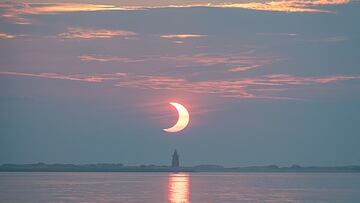Partial solar eclipse April 2022: what is the safest way to see it?
Looking directly at the Sun can cause serious damage to your eyes. So if you want to observe the partial eclipse on Saturday 30 April 2022, here’s how…

For those that find themselves in Antarctica, parts of South America and the Pacific, you’ll be in for a treat this weekend. The first of two partial solar eclipses in 2022 is taking place Saturday 30 April. A second will occur in the Northern Hemisphere in the fall.
Although not as awe-inspiring as a total eclipse of the Sun, partial solar eclipses are none the less spectacular astronomical events. The upcoming eclipse will see roughly 65 percent of the Sun blotted out by the Moon, appearing like it’s taking a bite out our local star.
Also see:
- Partial solar eclipse April 2022: when is it and from where can be seen?
- What is a Black Moon and how often does it occur?
- NASA's exoplanet count tops 5,000: is there life out there?
- What would NASA do if an asteroid were to hit Earth? When is the next asteroid coming?
- What do scientists say about Earth's core is in a 'Quite abnormal' superionic state?
How to safely watch a partial solar eclipse
You should never look directly into the Sun with the naked eye, it can cause serious damage to your eyes according to the American Academy of Ophthalmology. Even if it just for a short time your retina may be permanently damaged, even causing blindness, called solar retinopathy, without wearing the right eye protection.
The only time you can safely take off eclipse glasses is during a total eclipse, and only when the Moon has completely covering the entire disk of the Sun. This will be possible if you are in the “path of totality” but you must otherwise not take off your glasses elsewhere or at any other time during an eclipse, nor look directly at the Sun. “Totality” as it is known, lasts for a brief moment perhaps less than a minute in some locations, before it ends you will need to put your protective glasses on again.
You should only use solar eclipse glasses from companies whose products have been certified safe by authorities and purchased from reputable manufacturers. The American Astronomical Society provides a list of manufacturers and authorized dealers of eclipse glasses and handheld solar viewers that meet international standards for viewing a solar eclipse.
How to view a partial solar eclipse without protective eye wear
If you can’t get your hands on a pair of solar eclipse glasses you can make a DIY solar eclipse viewer relatively quicky with materials found in most households or easily acquired. You’ll need a box, a sheet of white paper, scissors, a pencil, some tin foil, tape and glue. Here is a handy video for putting together your homemade solar eclipse viewer.
When will there be eclipses in 2022?
There will be a total of four eclipses in 2022, two partial solar eclipses and two total lunar eclipses. Although the Northern Hemisphere will miss out on the first partial solar eclipse this weekend, come 25 October people from the east coast of Greenland to India will have an opportunity to view the celestial sight, with the best glimpse in Russia when almost 82 percent of the sun will be blotted out.
North Americans won’t be left completely out in the cold when it comes to astronomical wonders. They’ll be blessed with two chances to see a lunar eclipse, which will appear as a “Blood Moon” in some locations. These celestial events always occur about two weeks before or after a solar eclipse.
The first opportunity will be Monday 16 May 2022 visible in and Africa, Europe and North and South America. The second opportunity will come 8 November 2022, this time treating those stargazers from Eastern Europe across Asia and Oceania along with North and South America once again.






